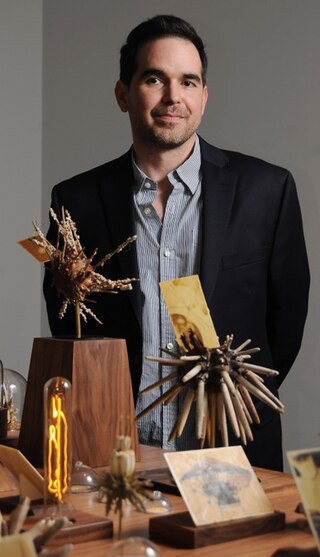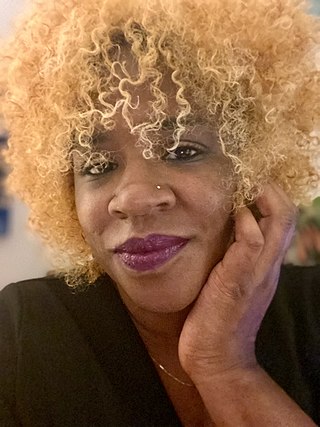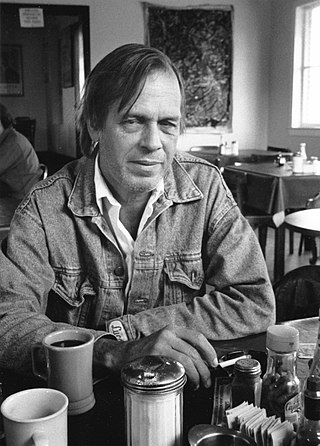Related Research Articles

Richard Avedon was an American fashion and portrait photographer. He worked for Harper's Bazaar, Vogue and Elle specializing in capturing movement in still pictures of fashion, theater and dance. An obituary published in The New York Times said that "his fashion and portrait photographs helped define America's image of style, beauty and culture for the last half-century".
Tracy Harris is an American artist, known for her abstract, encaustic paintings. Tracy Harris lives in Milford, Pennsylvania.
Robyn O'Neil is an American artist known for her large-scale graphite on paper drawings. She is also the host of the podcast "ME READING STUFF".

Dario Robleto is an American transdisciplinary artist, researcher, writer, teacher, and “citizen-scientist”. His research-driven practice results in intricately handcrafted objects that reflect his exploration of music, popular culture, science, war, and American history.
James W. Jack Boynton was an American artist.
Margaret Webb Dreyer was an American painter, muralist, mosaic artist, educator, gallery owner, and political activist who spent most of her career in Houston, Texas. Though she worked in a number of styles and media over the years, she was best known as an abstract expressionist painter. Her work won numerous awards in major juried shows and was exhibited widely in museums and galleries.
Dorothy Hood was an American painter in the Modernist tradition. Her work is held in private collections and at several museums, most notably the Museum of Modern Art and Museum of Fine Arts, Houston. Her preferred mediums were oil paint and ink.
Joyce J. Scott is an African-American artist, sculptor, quilter, performance artist, installation artist, print-maker, lecturer and educator. Named a MacArthur Fellow in 2016, and a Smithsonian Visionary Artist in 2019, Scott is best known for her figurative sculptures and jewelry using free form, off-loom beadweaving techniques, similar to a peyote stitch. Each piece is often constructed using thousands of glass seed beads or pony beads, and sometimes other found objects or materials such as glass, quilting and leather. In 2018, she was hailed for working in new medium — a mixture of soil, clay, straw, and cement — for a sculpture meant to disintegrate and return to the earth. Scott is influenced by a variety of diverse cultures, including Native American and African traditions, Mexican, Czech, and Russian beadwork, illustration and comic books, and pop culture.
Julie Speed is an American artist. After dropping out of Rhode Island School of Design at age 19, Speed spent her twenties moving around the U.S. and Canada working pickup jobs until moving to Texas in 1978, where she settled down and taught herself to paint. She switches back and forth regularly between oil painting, printmaking, collage, gouache and drawing, often combining disciplines. Two large volumes of her work, Julie Speed, Paintings, Constructions and Works on Paper, 2004 and Speed, Art 2003-2009 have been published by the University of Texas. She lives and works in Marfa, Texas. In her words, “I keep hours just like a real job, only longer, and in my spare time I read books, drink tequila, and garden.”
Laylah Ali (born 1968) is a contemporary visual artist known for paintings in which ambiguous race relations are depicted with a graphic clarity and cartoon strip format.
Barbara Crane was an American artist photographer born in Chicago, Illinois. Crane worked with a variety of materials including Polaroid, gelatin silver, and platinum prints among others. She was known for her experimental and innovative work that challenges the straight photograph by incorporating sequencing, layered negatives, and repeated frames. Naomi Rosenblum notes that Crane "pioneered the use of repetition to convey the mechanical character of much of contemporary life, even in its recreational aspects."
Audrey Jones Beck was an American art collector and philanthropist who donated her personal art collection to the Museum of Fine Arts, Houston. The John A. and Audrey Jones Beck Collection included impressionist and post-impressionist paintings, and the museum named its Audrey Jones Beck Building in her honor.
Kate Breakey is a visual artist known for her large-scale, hand-colored photographs. Since 1981 her work has appeared in more than 75 solo exhibitions and more than 50 group exhibitions in the United States, France, Japan, Australia, China, and New Zealand. Her work is in the permanent collection of many public institutions including the Center for Creative Photography in Tucson, the Museum of Photographic Arts in San Diego, the Museum of Fine Arts, Houston, the Wittliff collections at Texas State University, the Austin Museum of Art, the National Gallery of Australia in Canberra and the Osaka Museum in Japan. In 2004, she received the Photographer of the Year Award from the Houston Center for Photography.
Jermayne MacAgy was an American art museum specialist and professor.
Celia Álvarez Muñoz is a Chicana mixed-media conceptual artist and photographer based in Arlington, Texas.
Sedrick Ervin Huckaby (1975) is an American artist known for his use of thick, impasto paint to create murals that evoke traditional quilts and his production of large portraits that represent his personal history through images of family members and neighbors.
Lovie Olivia is an American multidisciplinary visual artist. She uses the media of printmaking, painting, and installations to explore themes of gender, sexuality, race, class and power.

Ayanna Jolivet McCloud is a visual and performance artist, writer, and educator from Houston, Texas. She is known for her minimalist aesthetic and multimedia sound performances.

Lucas Johnson was an American artist and major force in the Texas art scene from the late 1960s to the early 2000s. Largely self-taught, he mastered numerous techniques, including egg tempera, pen and ink drawing, silverpoint, oil and acrylic painting, and the printmaking disciplines of aquatint, etching, lithography, serigraphy, drypoint and mezzotint. He was inspired by politics, music, fishing and the culture of Mexico, where he lived for a decade. His unique vision found expression in a wide range of subjects, from haunting, shamanic beings and quirky aquatic life to enigmatic, volcanic landscapes and still lifes of the orchid species he collected and cultivated.
Alvia J. Wardlaw is an American art scholar, and one of the country's top experts on African-American art. She is Curator and Director of the University Museum at Texas Southern University, an institution central to the development of art by African Americans in Houston. She also is a professor of Art History at Texas Southern University. Wardlaw is a member of the Scholarly Advisory Council of the National Museum of African American History and Culture, and co-founded the National Alliance of African and African American Art Support groups in 1998. Wardlaw was University of Texas at Austin's first African-American PhD in Art History.
References
- 1 2 Gael Stack. Austin, Texas: University of Texas Press. 2011. pp. 180, 187. ISBN 9780292728547.
- ↑ Glentzer, Molly (20 December 2013). "Gael Stack's artistic vision remains constant". Houston Chronicle. Retrieved 2018-01-12.
- 1 2 Byars, Monica (March 2013). "The Unspoken Art of Gael Stack". www.uh.edu. Retrieved 2018-01-12.
- 1 2 McBride, Elizabeth. "Gael Stack". Artspace. 13: 64–66.
- ↑ "Gael Stack | Untitled | 2017 | Holly Johnson Gallery". www.hollyjohnsongallery.com. Retrieved 2022-03-28.